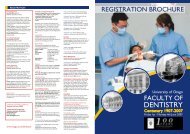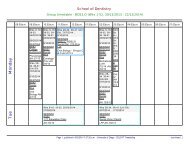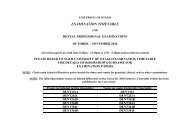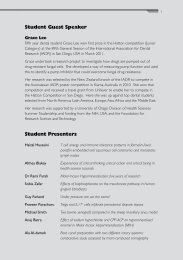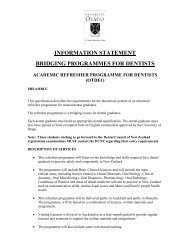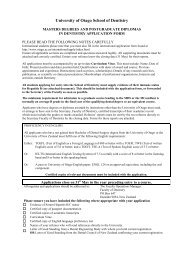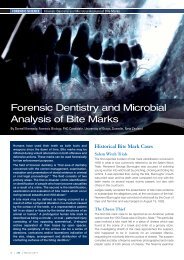2OO9 – 2O1O - Faculty of Dentistry - University of Otago
2OO9 – 2O1O - Faculty of Dentistry - University of Otago
2OO9 – 2O1O - Faculty of Dentistry - University of Otago
You also want an ePaper? Increase the reach of your titles
YUMPU automatically turns print PDFs into web optimized ePapers that Google loves.
Recent Publications<br />
Kardos RL, Cook JM, Butson RJ, Kardos TB. The<br />
development <strong>of</strong> an e-Portfolio for lifelong reflective<br />
learning and auditable pr<strong>of</strong>essional certification. European<br />
Journal <strong>of</strong> Dental Education 13: 135-141 (2009).<br />
Coates DE, Kardos TB, M<strong>of</strong>fat SM, Kardos RL. Educational<br />
perspective and progression <strong>–</strong> Dental Therapists and<br />
Dental Hygienists for the New Zealand environment.<br />
Journal <strong>of</strong> Dental Education 73: 1005-1012 (2009).<br />
36 FACULTY OF DENTISTRY RESEARCH REPORT 2009-2010<br />
MIKHAIL KENIYA<br />
MD Kandidat Nauk (Rostov State)<br />
Oral Sciences<br />
Research Fellow<br />
Mikhail Keniya’s main scientific interest is in the<br />
mechanisms <strong>of</strong> microbial resistance to environmental<br />
stressors. He studies the enzymology, molecular genetics<br />
and structural biology <strong>of</strong> membrane transporters, and<br />
carries out compound library screening.<br />
During 2009-2010, Mr Keniya was a co-investigator on<br />
research grants awarded to Pr<strong>of</strong>essor Richard Cannon<br />
(NIH grant”Fungal transporters: from resistance to new<br />
antifungals”, 2004-2009) and to Ann Holmes (NZ HRC-<br />
IIOF grant “Targeting melanoma initiation and progression:<br />
developing ABCB5 inhibitors”, 2009).<br />
Research and Collaboration<br />
Mr Keniya’s primary research focus was on the<br />
heterologous expression <strong>of</strong> the human-melanomaassociated<br />
transporter ABCB5 in yeast. Multiple<br />
genetic constructs were made, expressed in yeast and<br />
characterized. The resistance phenotype was enhanced<br />
using a 2-step random mutagenesis approach. This<br />
provided significant progress towards a yeast-based<br />
screening system for inhibitors <strong>of</strong> hsAbcb5p.<br />
The other research area involved screening libraries <strong>of</strong><br />
low molecular weight synthetic compounds obtained<br />
from the German chemical company MicroCombiChem.<br />
The collaboration was established by Dr. Brian Monk<br />
and led to a three-year Marsden fund project, starting<br />
in 2011. The response <strong>of</strong> yeast strains over-expressing<br />
membrane transporters which confer drug resistance<br />
in Candida identified compounds that were used to<br />
create structurally related “Families” for further rounds <strong>of</strong><br />
screening. Some promising (potent~ 1µM, stable soluble<br />
and non toxic) inhibitors <strong>of</strong> CaMdr1p were identified.<br />
These compounds belong to different but structurally<br />
related families. They are expected to provide insight into<br />
the structure <strong>of</strong> inhibitor binding sites and some may be<br />
prototype drugs.<br />
Recent Publications<br />
Cannon RD, Lamping E, Holmes AR, Niimi K, Baret PV,<br />
Keniya MV, Tanabe K, Niimi M, G<strong>of</strong>feau A, Monk BC. Effluxmediated<br />
fungal drug resistance. Clinical Microbiolology<br />
Review 22: 291-321 (2009).



